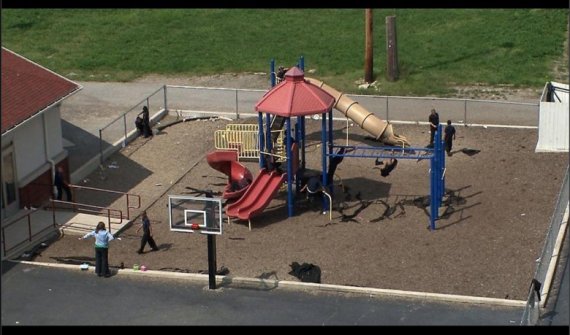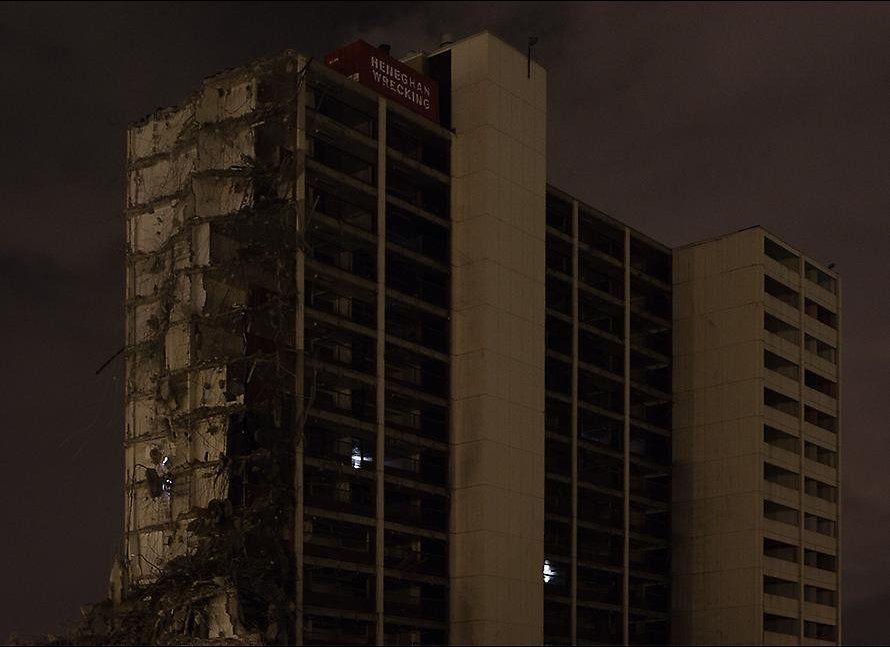Back in February, the Bloomberg administration's New York City Housing Administration (NYCHA) announced a land lease plan. The plan sought to offset public housing costs by leasing latent property to private developers. Contested by public housing tenants and by City Council, the plan has since been touted as a perversion of public policy legislation.

Many of the controversial public housing sites put forth by NYCHA are located on the Lower East Side, which make the neighborhood a natural choice of location for an exhibit examining public superstructures and the civic ideologies, which uphold them. On the corner of Stanton and Attorney, not far from the Smith, La Guardia, Baruch and Campos Plaza houses, light and sound artist Jan Tichy has installed Politics of Light, a series of works commenting on power and public policy.
Presented by Richard Gray Gallery with No Longer Empty (NLE), a New York-based not-for-profit which curates temporary exhibitions in vacant spaces, Politics of Light is the Chicago-based Tichy's first New York City exhibition. It is also the inaugural edition of No Longer Empty Presents, a series featuring solo exhibitions, a change from NLE's established group show programming.
Fittingly, the first piece in the exhibition is a multimedia installation entitled Project Cabrini Green, which documents the 2010 demolition of one of Chicago's last big housing projects. Comprised of a transparent model, single channel video and sound installation, Project Cabrini Green could in fact be termed an activist performance piece. To create the piece, Tichy collaborated with a group of children who were once Cabrini Green residents, asking each to compose a poem relating their experience of Cabrini Green as home. Tichy, who lives nearby in Ukrainian VIllage, allowed the children to personalize the rhythm of their poetry in tribute to local spoken word tradition, then programmed 134 individual LED lights to blink at a corresponding pace to each poem. These he placed in ammunition boxes (salvaged from the Israeli army), which he installed in each of Cabrini Greene's 134 apartments for the duration of the demolition period.
On Stanton street, we encounter Tichy's night-time video documentation of the project, lights blinking at intervals, while waiting for the next day's round of demolitions. On the floor, a little over a dozen ammunition boxes remain, with LEDs still flickering: those that have survived the violence. Across a platform supporting a transparent model of the vanished housing project, another video work, entitled Recess confounds our senses. Its sound track of children's playground noises creates a sort of cognitive dissonance -- we assume the sounds originate from the school we passed around the corner on our way here. Recess is a romantic hybrid -- a surprising emotional response to Tichy's minimal-meets-brutalist aesthetic: Are these the children of Cabrini Green, exiled and scattered? An archetypal representation of humanoids as interactive data bytes? The depressing reduction of individuals to institutional systemization?
Around the corner, Installation no. 18 is one of Tichy's signature light installations. He has strategically positioned two projectors, manipulating planes of moving light to creep across the rough unfinished surfaces of the industrial space. The site-specific result somehow reminds me of the underground crypt in Borromini's San Carlo alle Quattro Fontane. Tichy layers the light so that it feels deceptively soft at the center, but walking into its edges one feels the sharp, angular quality of his medium. It reminds me of the way choices work ... seemingly harmless in the moment, but stacked, accumulated over time, hard enough to kill.
Downstairs, I meet 1391, a diminutive model of a maximum-security Israeli prison built out of paper, its two dimensional cut-out pattern mounted on the wall adjacent. A projected light sweeps in alternating paths over the building, creating a perplexing sense of fabricated time. Back in 2007, when NLE director and Politics of Light curator Manon Slome discovered the Czech-born Tichy, he was building 1391 as part of a three-piece series, examining the inaccessibility of supposedly public structures as his graduate thesis (at the Bezalel Academy of Arts and Design in Israel).
At the time, Tichy's quest led him to employ Google in a paper-cut dollhouse commentary of civic edifices. Tichy scoured the Internet for buildings embodying the tension between collective civic responsibilities, our rights as individual citizens and the exploitation of said rights by an elected elite. He settled on Facility 1391, Dimona (Israel's controversial nuclear reactor) and the Yasser Arafat International Airport in Gaza. Each of these structures is uniquely accessible to the public via a carefully curated cyber-image, questioning the magnitude of ambiguity conveyed by these organisms and their fabricated public identities. Tichy embraced Google as a creative device for this series, resulting in an ironic meta-commentary on the abuse of power.
Next to the prison, a series of ominous-feeling digital videos span the length of the wall, reminiscent of Plato's Allegory of the Cave. Shadows flit across each moving image, challenging us to identify them as human or otherwise. At times creatures resembling moving machinery, fire or water enter the frame further disorienting our senses. I look for meaning in these images, and I can't find it, an apt reaction to an exhibit about power and politics: here I am, an individual seeking the illusion of control over my environment, disturbed by my own loss of power. My inability to reconcile my senses renders as danger, which recalls fear of the unknown -- an emotion, which government notoriously exploits to manipulate the masses.
The last and perhaps most beautiful work in Politics of Light is Installation no. 6. Tichy has repurposed an old television set as the dynamic base for this multi-new-media sculpture. The television lies on its back, screen parallel with the ground, supporting an array of vertical paper tubes of various heights. Tichy has programmed the display of the television to create traveling patterns of light, which illuminate the paper cylinders from below. Resembling a miniature metropolis, Tichy amplifies Installation no. 6's dimensionality by translating the light emissions into sound: more light corresponding to greater "white noise"; less light to the inverse.
Tichy cites Laszlo Moholy-Nagy as his inspiration for grafting reproductive technologies:
"I have already suggested that the phonograph be transformed from an instrument of reproduction into one of production; this will cause the sound phenomenon itself to be created on the record, which carried no prior acoustic message, by the incision of groove-script lines as required." (Photographs and Photograms)
The beauty of Installation no. 6 is its confusion. It is alive, thriving with overlapping systems in a dense mess of light and sound, a map of colliding systems and their biorhythms -- a city, an organism or a musical instrument.
Repurposing utilitarian media such as film, photography, television and even paper, Tichy renders our environment accessible at the same time that it remains intimidating. He draws our attention to the raw data we traffic in, coursing through the veins of the systems we traverse. Although in its critique of power, Tichy's work is reminiscent of Trevor Paglen, Richard Ross or Carolina Caycedo, ultimately Tichy does not fall into the trap of the revolutionary turned tyrant. He does not mimic the didactic or authoritarian mechanisms of those he criticizes, but rather casts them in a new light, allowing us to happen on new perspectives on our own.
His ephemeral use of raw light and sound lifts one above the polarity of good versus evil, public versus private, privileged versus destitute, and focuses our senses on the necessary ambiguity, the edges of our liminal existence, tuning us in to the peripheral. Humans can contain more than two basic positions. Navigating the gray zone is what it's all about. In Tichy's words "These are the edges we have to exist between".
As Bloomberg's term draws to a close and we stand in hope and uncertainty on the brink of a new era, Politics of Light empowers one to question whether Walter Benjamin may have been mistaken when he said, "All efforts to make politics aesthetic culminate in one thing, war." I'm banking on Benjamin being wrong.
____
Politics of Light runs Wednesday through Saturday, 2 - 7 pm at 196 Stanton Street. Closes December 14.
_____
